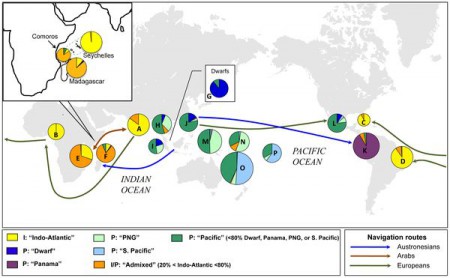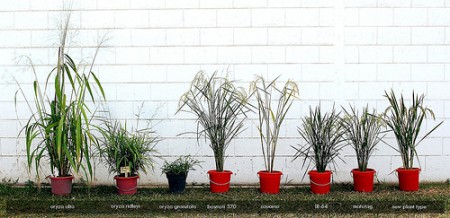- Diversity, geographical, and consumption patterns of traditional vegetables in sociolinguistic communities in Benin: Implications for domestication and utilization. 245 species, from 62 families, 80% wild-harvested.
- Landraces in situ conservation: A case study in high-mountain home gardens in Vall Fosca, Catalan Pyrenees, Iberian Peninsula. 39 landraces of 31 species, disappearing fast.
- Origin, history, morphology, production, improvement, and utilization of broomcorn [Sorghum bicolor (L.) Moench] in Serbia. Summarizes 60 years of experience.
- The timing of flowering in barley and sunflower dissected. In the former, variation in photoperiod sensitivity occurred both pre- and post-domestication. In the latter, variation is clinal.
- Cultivated and wild Solanum species as potential sources for health-promoting quality traits. Some of the latter are pretty good.
- Microsatellite fingerprinting in the International Cocoa Genebank, Trinidad: accession and plot homogeneity information for germplasm management. A quarter of plots were mixtures. Well that’s no good. Huge amount of stuff in this issue of PGR-CU.
- Construction of an integrated microsatellite and key morphological characteristic database of potato varieties on the EU common catalogue. So that the above doesn’t happen.
- Footprints of selection in the ancestral admixture of a New World Creole cattle breed. Lots of African and zebu blood in Guadeloupe cattle.
- Inventory of related wild species of priority crops in Venezuela. Basically a big list.
- Potential of herbarium records to sequence phenological pattern: a case study of Aconitum heterophyllum in the Himalaya. Could be used to flesh out the above kind of thing.
- Refugia: identifying and understanding safe havens for biodiversity under climate change. How to spot refugia past and future, which would be useful for the above-but-one kind of thing.
- Modelling biome shifts and tree cover change for 2050 in West Africa. Climate change leads to greening, human impact to browning.
- Comparison of modern and historical fish catches (AD 750–1400) to inform goals for marine protected areas and sustainable fisheries. Along the Kenyan coast. Amazingly, comparisons are possible, and they show a deterioration in quality and quantity.
- The biodiversity benefits of botanic gardens. They are there, despite their history with invasives, but gardens need to get their act together. Which they are doing.
- Domesticated crop richness in human subsistence cultivation systems: a test of macroecological and economic determinants. Number of crop species grown depends on latitude, habitat heterogeneity and commitment to agriculture (as opposed to foraging, herding and exchange). Can’t make up my mind if this is interesting or predictable. Maybe it is both. Would be great to apply same method to infraspecific diversity too.
- The age of monumental olive trees (Olea europaea) in northeastern Spain. Maybe over 600 years.
Nibbles: Beautiful models, Beautiful bank, Organic FAO, Eskimo diet, Indian medicinals, Maya nut studentship, Fishy infographics
- Official confirmation of the need for better crop growth models.
- More on CIP’s high-tech spud bank. In other news, CIP also has banks of other Andean roots/tubers, but don’t get me started on that one.
- “FAO has relegated organic agriculture to a footnote in the discussion of food security in the long run.” Fighting talk. Wonder if that will change with the new DG.
- Cook like an Inuit.
- Cultivating medicinal plants in India. Let’s see how that goes.
- Wanna study the Maya nut?
- More great Guardian infographics, aquatic edition.
- “This one tastes like cotton candy.” Breeding strawberries the hard way.
Coconut origins explained
The picture really is worth a thousand words, but if you still want the words…
Rice domestication roundup
In the past few weeks there’s been a number of papers on the genetics of rice domestication. I’ll just give you the main findings here, and leave you to battle with the details on your own. With the help of various other bloggers.
Dorian Fuller did a great job of summarizing the multiple domestication (or indica and japonica) theory at The Archaeobotanist a couple of weeks back. This seems to have the upper hand at the moment. Wild perennial rice is cultivated in wetland margins in the Neolithic Yangtze, and as the water ecology begins to be altered by humans, creating seasonal drought conditions to stimulate seed production, particular adaptations are selected (annuality, short stature, less branching etc.), which leads to the domestication of japonica rice. This is then taken to the area of an independently-domesticated proto-indica, probably around 3800-4000 years ago, and some genes are exchanged. So far, so good, and there is now a pretty comprehensive database of rice archaeology to back up the recent studies of single and multiple genes.
Well, certainly the “genetic and selective basis for domestication” seem to be different for japonica and indica, but another recent paper throws some doubt on the multiple domestication idea. Now, I’ve briefly discussed this with people who know a lot more about rice than I do and it seems the main sticking (as it were) point is the dating of the indica-japonica split to 3,900 years ago. Previous estimate were in the hundreds of thousands of years, supporting the multiple domestication theory, but the problem is that the newer, lower estimate was based on domestication genes only. Lots more argument on the horizon, I suspect.
Nibbles: Cryo, Tree diversity, Agroforestry, Seed industry, Trigonella, Ancient MesoAmerica, Niche models
- CIP’s high-tech genebank.
- “The project’s eventual aim is to plant several thousand trees at sites across Perthshire to act as a ‘living gene bank.'” What, because normally genebanks are dead?
- Millennium Seed Bank joins ICRAF’s BusyTrees thing. Which you can follow in about a million different social networking ways.
- Conservation Magazine does a number on crop improvement. Wait, what? Conservation Magazine? Yep, and with teaching resources.
- Fenugreek, barkeep, and make it a double.
- Ancient chocolate and corn routes.
- What species distribution models do you like?

